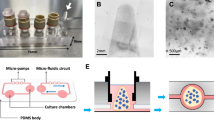Summary
A novel in vitro human prostate cancer model was established by using a coculture technique in which isolated human prostate fibroblasts were observed to grow as a mixed culture with isolated human prostate cancer cells (LNCaP) on microcarrier beads under microgravity-simulated conditions. This model appears to be promising and deserves further exploration because: (a) cocultured human prostate fibroblasts and cancer epithelial cells appear to undergo patterns of histogenesis similar to those observed in human prostate tumors and (b) unlike the conventional cell culture on plastic dishes, cocultured human prostate fibroblasts and LNCaP cells in microgravity-simulated conditions responded to the inductive signals of growth and differentiation from dihydrotestosterone in a manner similar to that observed in the in vivo condition. These results offer an opportunity to examine molecular mechanisms of cellular signaling in response to androgen stimulation during normal and aberrant human prostate development. The microgravity-simulated three-dimensional prostate epithelial cell culture with prostate fibroblasts can be further explored as an ideal in vitro model for the study of normal and neoplastic prostate development. This model could also be adopted as a drug screening program for the discovery of novel therapeutic agents in the treatment of human prostate cancer and benign hyperplastic growth.
Similar content being viewed by others
References
Becker, J. L.; Prewett, T. L.; Spaulding, G. F., et al. Three-dimensional growth and differentiation of ovarian tumor cell line in high aspect rotating-wall vessel: morphologic and embryologic considerations. J. Cell. Biochem. 51(3):283–289; 1993.
Camps, J. L.; Chang, S. M.; Hsu, T. C., et al. Fibroblast-mediated acceleration of human epithelial tumor growth in vivo. Proc. Natl. Acad. Sci. USA 87(1):75–79; 1990.
Chang, S. M.; Chung, L. W. Interaction between prostatic fibroblast and epithelial cells in culture: role of androgen. Endocrinology 125(5):2719–2727; 1989.
Chomczynski, P.; Sacchi, N. Single-step method of RNA isolation by acid guanidinium thiocyanate-phenol-chloroform extraction. Anal. Biochem. 162:156–159; 1987.
Chung, L. The role of stromal-epithelial interaction in normal and malignant growth. Cancer Surv. 23:33–42; 1995.
Chung, L. W.; Chang, S. M.; Bell, C., et al. Co-inoculation of tumorigenic rat prostate mesenchymal cells with non-tumorigenic epithelial cells results in the development of carcinosarcoma in syngeneic and athymic animals. Int. J. Cancer 43(6):1179–1187; 1989.
Chung, L. W. K.; Coffey, D. S. Biochemical characterization of prostatic nuclei I. Androgen-induced changes in nuclear proteins. Biochim. Biophys. Acta 247(570):570–583; 1971.
Chung, L. W.; Gleave, M. E.; Hsieh, J. T., et al. Reciprocal mesenchymal-epithelial interaction affecting prostate tumour growth and hormonal responsiveness. Cancer Surv. 11:91–121; 1991.
Chung, L. W. K.; Matsuura, J.; Runner, M. N. Tissue interactions and prostatic growth. I. Induction of adult mouse prostate hyperplasia by fetal urogenital sinus implants. Biol. Reprod. 31:155–163; 1984.
Cunha, G. R.; Chung, L. W. K. Stromal-epithelial interaction: I. Induction of prostatic phenotype in urothelium of testicular feminized (TFm/y) mice. J. Steroid Biochem. 14:1317–1321; 1981.
Freed, L. E.; Vunjak, G.; Blum, J. K., et al. Effects of shear on in vitro chondrogenesis. In Vitro Cell. Dev. Biol. 30A:53; 1994.
Gleave, M.; Hsieh, J. T.; Gao, C. A., et al. Acceleration of human prostate cancer growth in vivo by factors produced by prostate and bone fibroblasts. Cancer Res. 51(14):3753–3761; 1991.
Goodwin, T.; Jessup, J.; Da, W. Morphologic differentiation of colon carcinoma cell lines HT-29 and HT-29KN in rotating-wall vessels. In Vitro Cell. Dev. Biol. 28A:47–60; 1992.
Jacob, S. C. Spread of prostatic carcinoma to bone. Urology 21:337–344; 1983.
Jessup, J. M.; Goodwin, T. J.; Spaulding, G. Prospects for use of microgravity-based bioreactors to study three-dimensional host- tumor interactions in human neoplasia. J. Cell. Biochem. 51(3):290–300; 1993.
Lasnitzki, I.; Mizuno, T. Prostatic induction: interaction of epithelium and mesenchyme from normal wild-type mice and androgen-insensitive mice with testicular feminization. J. Endocrinol. 85(3):423–428; 1980.
Marengo, S. R.; Chung, L. W. K. Prostatic growth is induced by intraprostatic injection of growth factors. J. Androl. 15(4):60–71; 1994.
Prewett, T.; Goodwin, T.; Gf, S. Three-dimensional modeling of T- 24 bladder carcinoma cell line: a new stimulated micro-gravity culture vessel. J. Tiss. Cult. Method 15:29–36; 1993.
Schroedl, N. A.; Akins, R. E.; Molnar, G. R., et al. Culture of cardiac and skeletal muscle cells in the NASA bioreactor vessel. In Vitro Cell. Dev. Biol. 30A:53–54; 1994.
Schwarz, R.; Goodwin, T.; Wolf, D. Cell culture of three- dimensional modeling in rotating-wall vessels: an application of simulated microgravity. J. Tiss. Cult. Method 14:51–58; 1992.
Thalmann, G. N.; Anizinis, P. E.; Chang, S. M., et al. Androgen-independent cancer progression and bone metastasis in the LNCaP model of human prostate cancer. Cancer Res. 54:2577–2581; 1994.
Zhau, H. Y. E.; Hong; S. J.; Chung, L. W. A fetal rat urogenital sinus mesenchymal cell line (rUGM): accelerated growth and conferral of androgen-induced growth responsiveness upon a human bladder cancer epithelial cell line in vivo. Int. J. Cancer 56(5):706–714; 1994.
Zhau, H. Y. E.; Wan, D. S.; Zhou, J., et al. Expression of c-erb B-2/neu proto-oncogene in human prostatic cancer tissues and cell lines. Mol. Carcinog. 5:320–327; 1992.
Author information
Authors and Affiliations
Rights and permissions
About this article
Cite this article
Zhau, H.E., Goodwin, T.J., Chang, SM. et al. Establishment of a three-dimensional human prostate organoid coculture under microgravity-simulated conditions: Evaluation of androgen-induced growth and psa expression. In Vitro Cell.Dev.Biol.-Animal 33, 375–380 (1997). https://doi.org/10.1007/s11626-997-0008-3
Issue Date:
DOI: https://doi.org/10.1007/s11626-997-0008-3




